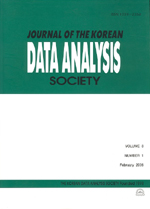8주간의 근력 트레이닝에 따른 체구성과 근력간의 관련성
Correlation on Body Composition and Muscle Strength of Strength Training during 8 Weeks
- 한국자료분석학회
- Journal of The Korean Data Analysis Society (JKDAS)
- Vol.16 No.5
-
2014.102651 - 2660 (10 pages)
- 72

본 연구의 목적은 8주간의 근력 트레이닝에 따른 체구성 변화율과 근력 변화율 간의 상호 관련성을 알아보고, 근력을 체중과 근육량 각각으로 상대값을 산출하여 그 차이를 검토하는 것이다. 본 연구를 위해 운동 경험이 없고 근골격이나 심폐에 이상 소견이 없는 건강한 남자성인 52명을 대상으로 체성분 검사와 근력검사를 실시하였고 8주간 근력트레이닝을 실시하였다. 본 연구의 결과에서 체중과 체지방률은 유의한 변화가 없었던 반면에 근육량은 유의한 증가가 나타났다. 그리고 체구성 변화율과 근력 변화율 간의 관계에서 견관절 우측의 신전근력을 제외하고 견과절과 슬관절 근력 변화율과 각 체중 변화율, 체지방률 변화율 간에 부적 상관관계를 나타낸 반면에 근력 변화율과 근육량 비율 변화율 간에는 정적 상관관계를 나타냈다. 본 연구에서 근력은 상대적으로 체중의 영향을 받지 않는 견관절 근력과 상대적으로 체중의 영향을 많이 받는 슬관절 근력으로 구분하여 평가하였는데 견관절 근력 변화율과 슬관절 근력 변화율 각각이 체구성 변화율과 유사한 정도의 상관관계를 나타냈다. 그리고 견관절 우측의 신전 및 굴곡 근력 변화율을 제외하고 체중 당 근력 변화율보다 근육량 당 근력 변화율로 환산했을 때 근력 트레이닝에 따른 근력의 증가가 더 있는 것으로 나타났다.
The purpose of this study was to investigate correlation on body composition and muscle strength of strength training during 8 weeks. The subjects were comprised 52 adult males. Body composition and muscle strength were measured. Then, shoulder and knee joint isokinetic strength were tested at each angular velocity (shoulder joint 60°/sec; knee joint 60°/sec). As a result, weight and %fat were no significant effect of training. But muscle mass was a significant effect of training. The result of correlation revealed negative correlation between shoulder/knee strength change rate and weight/%fat change rate, positive correlation between shoulder/knee strength change rate and muscle mass change rate. Muscle strengthening in strength per muscle mass was significantly higher than strength per weight. In conclusion, the results of this study demonstrate that body composition and muscle strength have significant relationship in adult males.
1. 서론
2. 연구 방법
3. 결과
4. 논의
5. 결론
References
(0)
(0)